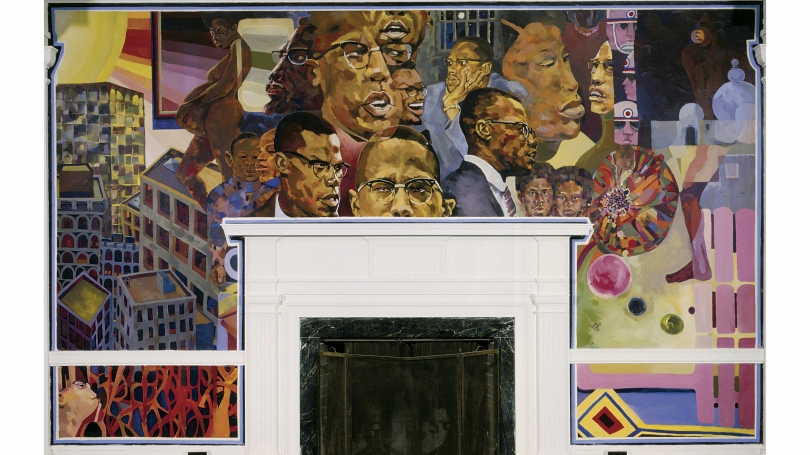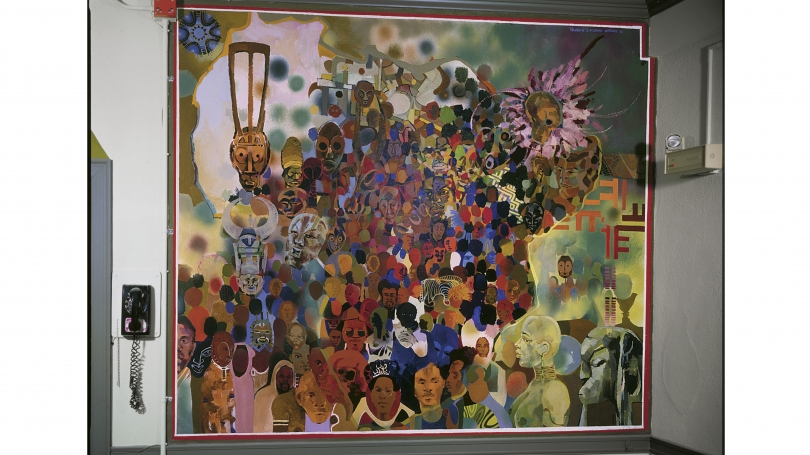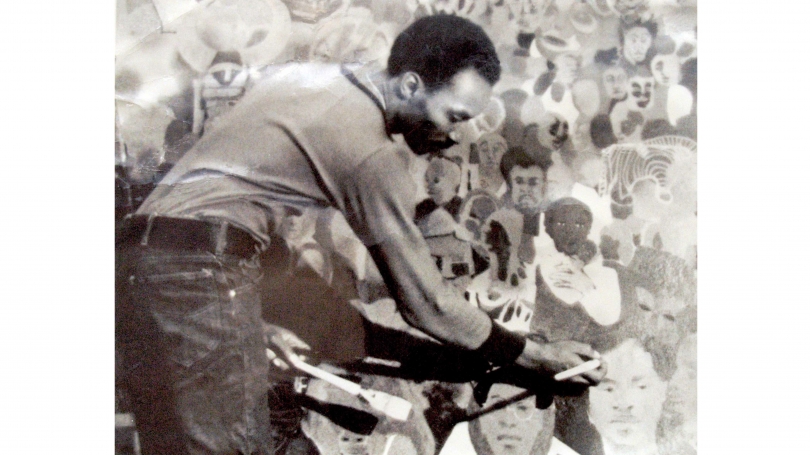Florian Jenkins and The Life of Malcolm X (1972) at Dartmouth College
Hood Quarterly, summer 2014
Crishuana Williams
Crishuana Williams, Class of 2012, sat down with artist Florian Jenkins to discuss the mural titled The Life of Malcolm X (1972), forty years after he painted the panels in Cutter-Shabazz Hall at Dartmouth College. Below is a condensed account of the mural commission, based on Williams's forthcoming essay in the Hood Museum of Art's multi-author brochure on the work and its history, to be published in fall 2014.
"I felt the need for us, as a body, to create and to unite. [The mural] was created to set up a demand within the community to move towards racial consciousness. The consciousness of El Hajj Malik Shabazz Temple is a burning spirit. The man [Florian Jenkins] did exactly what he wanted to do. May the spirit live on forever."
—Cleveland Webb, Class of 1971 and chairman of Dartmouth's Afro-American Society, in the press release for the community unveiling of The Life of Malcolm X
In 1972, when Florian Jenkins was commissioned to create a mural at Dartmouth College, the modest and relatively young artist was both director of his own commercial gallery, Mid-Block Art Service in East Orange, New Jersey, and an established muralist. He was also proficient in portraiture, design and commercial printing procedures, photography, easel painting, and the artist lecture circuit. The Life of Malcolm X would become one of his better-known works, perhaps because it reflected both his talent and his sense of purpose. Nelson Armstrong, Class of 1971, recalled his initial reaction to Jenkins's arrival on campus: "His work was bold and impressionistic. Yet I remembered him as small and soft-spoken. He made his presence felt by giving his time when students bothered him. El Hajj Malik El Shabazz Temple was a testament to his life."(1)
As a member of the community art tradition, Jenkins understood Webb's exhortation in the press release quoted above. This mural was rooted in self-pride and self-sacrifice and presented a means for the black students on campus to see themselves on Dartmouth's actual walls and to renew the commitments they had made to their home communities. Though the first black student at Dartmouth, Edward Mitchell, graduated in 1828, there were never more than five black students per class until 1965, when the College's admissions department and the Tucker Foundation backed current black students in the recruitment of others from inner-city schools throughout the country (known as the Dartmouth Bridge Project, it would become the loose foundation of the A Better Chance program). In the late 1960s, the ninety or so black students then on campus formed the Afro-American Society, and in 1972 the society commissioned Florian Jenkins to paint The Life of Malcolm X on the walls of their dormitory. These students who had concerned themselves intellectually with all aspects of blackness sought to do the same visually. Dartmouth's cozy isolation would not serve as either excuse or political refuge from the larger issues of their communities.
In an artistic dialogue with the black arts movement of the 1960s and 1970s, the murals were intended to be "reflective of the thinking of Black students on campus," proclaimed Afro-American Society Chairman Ronald Copeland, Class of 1972. Jenkins arrived on campus and worked with students through informal meetings, interviews, and group discussions to determine ways of connecting Malcolm X and the Dartmouth community, and the mural, which took five months to complete, came to represent a form of collective memory building and engagement as well as a vehicle for his own artistic interpretations. Jenkins literally incorporated the students as well, painting the faces of those around him in the lounge as he worked.(2)
In the panels overall, Jenkins presented his vision of a strong young core of blacks dedicated to "the struggle" for social/economic equality and self- determination, in the tradition of Malcolm X. In his artist statement, he wrote, "The images serve to reflect the nature of the struggle they have identified and are committed to." He attempted to reflect the experiences and ambitions of the students for whom he made the mural: "I was really impressed with them and their sense of adultness, their sense of purpose. Up here, so far away from their centers and urban areas that they had come from, but to be so dedicated, to be so focused in terms of where they wanted to go."(3)
To understand the mural forty years later, one must understand both Jenkins's passionate idealism and his pessimism—he sought to frame a relationship between the experiences of these students at Dartmouth, the of Malcolm X, and the experiences of blacks globally, in a Pan-Africanist sense. In 2012, he reflected, "I just look at them for what they are and they stand for what they are. They really speak for themselves. Art has to speak for itself. You can't stand there and explain it. If it doesn't say what you intended it to say, then you've failed. So if it communicates the idea to the viewer, then the artist has succeeded."(4)
Notes
1. H. Elden Hodges, unpublished manuscript titled The Temple Murals, 1988.
2. Hodges, 1988.
3. Crishuana Williams, unpublished interview with Rev. O. Florian Jenkins titled "The Shabazz Temple Muralist: 40th Anniversary Interview," 2012.
4. Williams, 2012.
Related Exhibitions
- Witness: Art and Civil Rights in the Sixties
- Reflections in Black: Smithsonian African American Photography: Art and Activism
Related Stories
- Florian Jenkins, The Life of Malcolm X (June 15–October 15, 1972)
- Hood Quarterly, "Alumni Voices: Dartmouth in the Civil Rights Era"


